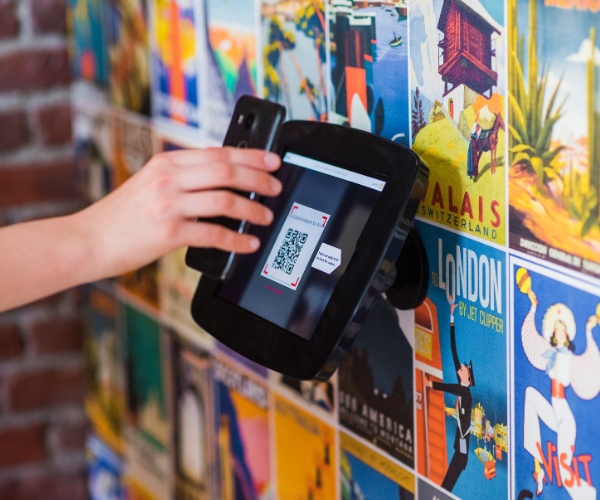Recently, we shared some ways that business owners and brand marketers can use QR codes in their marketing campaigns. While driving consumers to web pages is an obvious goal of many campaigns, it’s just one of the numerous benefits. From boosting brand awareness to increasing engagement and leads, QR codes can be used to accomplish a number of goals.
However, executing successful campaigns takes more than just throwing QR codes onto out-of-home advertisements and expecting new sales. Like other marketing campaigns, QR codes require you to know your audience and inspire them to take action.
So, how should brands deploy QR code marketing? And what are some best practices they should follow? Below, we’ll outline some tactical tips that can help you get the most from your campaigns. While this three-step process may be simplified, it should serve as a primer to get you thinking about implementing QR codes into your marketing strategy.
1. Know Your Audience
To start, you must know who’s interacting with your company. This means considering the context of the physical space your consumers will be engaging with your QR codes—and knowing where they may be in their customer journey. If you’re a restaurant, for example, you want to drive new customers and increase food sales. This means reaching local patrons in locations that are convenient for them.
In 2020 (and beyond) contactless dining is not only convenient, it’s also compliant with CDC guidelines. In this context, restaurants can use QR code menus in their dining areas and beyond to create a safe, contactless experience. However, codes can also drive diners to videos of messaging from your chef; or provide important information like where the ingredients are sourced or additional content that creates a more immersive dining experience. This holistic approach to creating better experiences can increase average ticket size, improve the frequency of visits, and boost the lifetime value of customers.
Giving patrons multiple access points to your restaurant helps to build brand and expands your footprint beyond your physical location and makes you more convenient, a competitive advantage in any climate. Sticking with the angle of a restaurant owner, you can use QR codes to reach hungry consumers who may be enticed to order delivery while at a bus stop waiting for public transportation. Or, you can reach busy parents looking for a quick dinner that are picking up their kids in the lobby of a daycare facility.
2. Tell Them What to Expect
Regardless where you’re reaching consumers, it’s important to be as explicit and instructive as possible to your users. By reducing all potential barriers to entry, you should tell your end users where your CTAs are driving them, let them know what to expect. One of the most obvious ways to use QR codes is for discounts, promos, and other sales-driven initiatives—as is often the case of e-commerce marketing. However, your QR codes don’t always have to link out a hard-discount or lead generation mechanism.
It’s a common misconception that QR codes can only link out to web addresses. As we’ve reviewed, QR codes can link out to instructional videos, in-store payments, map locations, contact cards, and a whole lot more. It’s also possible to integrate them into your current marketing efforts. Let’s say you’re an in-house marketer at a software company who’s tasked with generating new leads. QR codes can shorten the customer journey by directly inspiring them to visit a signup page, contact form, or to download your most recent white paper.
For example, SaaS companies can use QR codes to direct users to a download page of an app. And sales teams can link out to product demos. By circumventing the need for paid search or paid social, you can drive users to places you want them—all without the added expense of a pay per click advertising model. Driving traffic directly to your content offer creates an instant connection with your users and circumvents other paid channels and potential competition in search results, meaning you get great insight about your core audience and do it more efficiently.
3. Get Creative
Did you know that QR codes come with customization capabilities? While many people may assume that the standard black and white color pallet is the only option for QR codes, this couldn’t be farther away from the truth. Using color is one of the easiest ways for codes to stand out. Much like other branded efforts—like your logo and web design—selecting background and foreground colors that are in high contrast with each other can help draw consumers in.
From using custom frames to design elements, brands can get creative and match their QR codes around their visual brand identity. Brands can also add short phrases in their codes (such as “Scan Here!” or “Scan Now!”) to further entice users to use their codes. And of course, they should use call to action messages below their codes to tell users what to expect (an important tactic that we just reviewed).
While flexing your creative muscles is recommended, it’s also important to be intentional with your efforts. Better branding means better brand awareness. But at the end of the day, it’s important that people recognize it’s a QR code. However, by understanding your audience, telling them exactly what to expect, and using your brand elements to you advantage, you can create QR marketing campaigns that are engaging, instructive, and successful.
Download the QR Code Marketing eBook about adding value to the customer journey thru the use of QR Codes.
Special thanks to https://www.proxyclick.com for the great QR Code scan image seen above.
